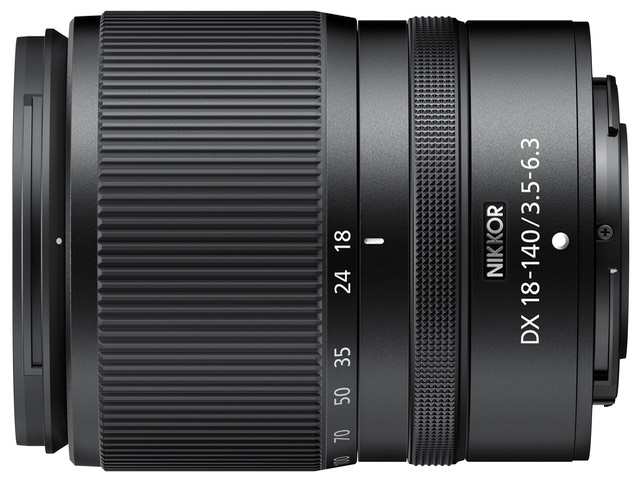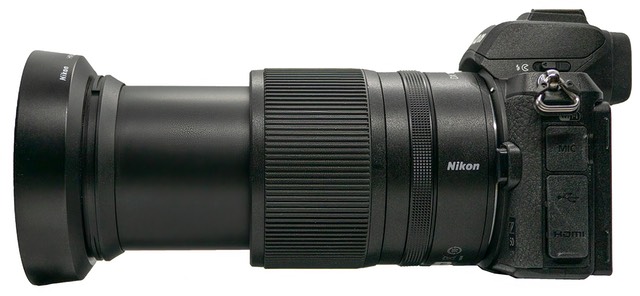= = = = = = = = = = = = = = = =
Nikon Z Camera Owners: Up-to-date information and new articles by Thom Hogan are available at zsystemuser.com, which continues to follow all Nikon mirrorless camera news and information in 2026 and the future.
= = = = = = = = = = = = = = = =

What is it?
Nikon's third DX lens is the 18-140mm f/3.5-6.3 VR DX.
In the consumer DSLR world Nikon got into the habit of producing 18-xx zooms. We had 18-55mm (three versions), 18-70mm, 18-105mm, 18-135mm, 18-140mm, 18-200mm, and even 18-300mm variations. These are true consumer zooms, most patterned after the very successful Tamron 28-200mm lens that started the superzoom era. The 18-140mm f/3.5-6.3 DX reviewed here is indeed essentially an equivalent of that original Tamron, working out to a 27-210mm equivalent. (Given that the Japanese round focal lengths liberally, I wouldn't put much into the difference.)
Somehow Nikon has slightly downsized the Z-mount version of this lens from the F-mount. At 3.6" (90mm) collapsed and 2.9" (73mm) in diameter, it drops about 10% of the bulk from the F-mount version. Moreover, at 11.2 ounces (315g), it sheds a full 6 ounces (170g) from the DSLR lens. Both these reductions are beneficial, as coupled with the Z50 body (compared to a D3500 body), you end up with a capable travel companion that simply packs smaller and lighter, and thus more likely to come with you.
Nikon's hoping that ~28mm equivalent at the wide end is enough to get you to adopt this lens as the one that sits on the front of your Z50 (or maybe Zfc) permanently. Personally, I don't think 28mm equivalent is wide enough for a true travel lens. I would have preferred a 16-105mm (24-150mm equivalent) myself. The problem is that Nikon sold over one million of those DSLR 18-140mm lenses, so they weren't about to make a change; they think you want 28-200mm.
Focal lengths on the lens are marked at 18mm, 24mm, 35mm, 50mm, 70mm, 100mm, and 140mm. Zooming to 140mm extends the inner front barrel by about 50mm, which adds about 50% to the overall length. There is no mechanism to lock the focal length at 18mm for travel, or to a specific focal length during use. Fully extended, the lens adds 1.7" (45mm) in length.

Maximum aperture changes as you zoom:
- 18mm — f/3.5
- 23mm — f/3.8
- 29mm — f/4
- 34mm — f/4.2
- 39mm — f/4.5
- 46mm — f/4.8
- 55mm — f/5
- 68mm — f/5.3
- 88mm — f/5.6
- 105mm — f/6
- 140mm — f/6.3
Optically, the 18-140mm f/3.5-6.3 DX is somewhat sophisticated, with 17 elements in 13 groups, and two of those elements are aspherical, with two ED glass. That's an additional group, an additional aspherical, and an additional ED lens compared to the F-mount version.
Nikon also changed the close focus performance of the Z-mount lens, opting to let it have a variable close focus distance (0.2m at 18mm up to 0.4m at 140mm) and providing a 1:3 maximum magnification. Both those things are better than the F-mount lens (though note my comments in the performance section, below). Focus breathing is said to be suppressed (again, see my notes in performance section).
The 18-140mm f/3.5-6.3 DX also includes in-lens VR (vibration reduction), which Nikon claims produces a 5-stop advantage (using CIPA measurement standards). Since none of the current Z DX bodies have sensor-VR, it's not surprising that all the Z DX lenses have lens-based VR.
Up front, the filter size is now 62mm (down from 67mm), and internally the lens uses a seven-blade aperture diaphragm. There are no switches or buttons on the lens.
While Nikon advertises the lens as having a dust-proof and drip-resistant structure, but there is no rubber sealing gasket at the lens mount, and the front element is not fluorine coated.
The lens is made in Thailand and sells for US$600. No lens hood is supplied with the lens (HB-101 is the optional hood).
Source of the reviewed lens: purchased.
How's it Handle?
There's not a lot to say. The big zoom ring on the front is easy to find, and while slightly rough compared to the higher-end S lenses, still rotates easily and without any hitches. The focus ring closer to the camera is the usual very smooth fly-by-wire type we've come to expect on the Z-mount lenses.
There's a tiny bit of wobble possible when the lens is fully extended on my sample, but I didn't notice this having any impact on images.
A Z50 with this lens mounted feels quite well-balanced, even fully extended.
While waiting for Nikon to produce the HB-101 lens hood (another in the long line of "we didn't get the accessories done with the product"), I've been using an HN-22, which isn't optimal, but works to keep side light off the lens and reduces veiling flare.
How's it Perform?
Focus: focus breathing is reasonably well suppressed, something you don't expect in a consumer, crop-sensor zoom. Also, while the lens is not parfocal, it's not as varifocal as most zooms, meaning that small zoom changes have very minimal focus impact to the point where sometimes you can ignore them. Focus was also reasonably snappy for a consumer lens, though at 140mm at times I could see some slightly slower results.
Stabilization: Surprisingly good, with perhaps a five-stop suppression if handled well. Certainly better than the older F-mount version (plus you also have a Sport setting for panning).

Literally one of the first images I took with the 18-140mm (as it arrived just before I got on a plane to Botswana). 140mm, wide open. So how's it look close up?

Sharpness: This lens tends to be best wide open. Indeed, at 18mm there's little difference in the center between f/3.5 and f/5.6, and eventually diffraction starts to take a toll. I'd call the central performance very good at 18-70mm, good at 70-140mm. Corners fare worse, being only good, and maybe even just fair at some focal lengths (surprisingly not predictable, probably due to aspherical elements moving during zoom/focus).
At 18mm, you need to stop down to f/5.6 to bring the edges to their best level, which I'd then judge as good. As you zoom in, the corners get better wide open, with 50-70mm being the very good and nearly matching the center. No need to stop down at those focal lengths. From 100mm upwards, the lens starts to revert to being better in the center, rougher in the corners, and needing a stop or two smaller aperture to get best results.
At close distances, the lens fares somewhat worse, being only marginally good in the center at the extreme, and barely fair in the corners.
There's only minor field curvature with the lens, with the wide angle end having a bit more than the telephoto end. Some coma is present wide open, though generally moderated by stopping down.
Linear Distortion: You can't turn the correction off in camera. A small amount of barrel distortion at 18mm (~1%) with corrections applied, but virtually no distortion at longer focal lengths. Without correction, large barrel distortion at 18mm, which changes to pin cushion very quickly (may be even by 24mm).
Chromatic Aberration: Virtually no longitudinal chromatic aberration, which is to be expected for a variable aperture zoom like this. Lateral chromatic aberration was fairly low and well controlled, but if you turn off the in-camera corrections, you may see a pixel width CA wide open at the longest focal lengths (between 18 and 70mm the lens is well-behaved).
Vignetting: At 18mm, highly visible corner vignetting, though with a reasonably wide non-affected area. Stopping down to f/5.6 makes it ignorable. By 24mm, the corner vignetting is low and mostly ignorable, even wide open. The lens stays that way until about 100mm, where the corners start showing a strong (1.5+ stop) darkening again. Ironically, the in-camera corrections don't work particularly well at default settings. You'd be better off stopping down one stop in most cases.
Flare: Probably the worst characteristic of the lens, as the lens can produce multiple, colored element reflections with in-frame light sources that are bright. The best case is 140mm, the worst case is at the wide angles.
Bokeh: Some cats eye at 18mm, which goes to none by 35mm and begins to reappear at 70mm and increases from there. Aperture diaphragm is slightly irregular at f/8 and smaller, though better than many Nikkors. Clear onion skin within bokeh balls, with very little edge brightening at some focal lengths (worst at 18mm). Surprisingly good overall performance for a kit lens, though forcing out of focus areas is obviously a little more difficult due to the slowish apertures.
Compared to the F-mount version: First off, somewhat smaller and lighter, which in itself is a benefit considering that coupled with the current Z DX bodies, you end up with a significantly smaller kit. I'd tend to say optically that the lenses are similar in terms of sharpness, but the Z-mount's lens corrections are better.
Compared to the 16-50mm: Technically, the kit lens tends to do a little better than this lens at equivalent focal lengths and apertures. Moreover, there's far less difference between center and corner on the 16-50mm. Where the 18-140mm excels is in limiting chromatic aberrations and linear distortion.
Final Words
Personally, I don't like the 18-xx zoom choices that Nikon keeps making for DX. The problem is that 18mm isn't particularly wide angle, so you end up with a mid-range zoom that's more telephoto than wide. I'd have preferred 16-100mm simply because it would be more useful in more situations. But the 28-210mm equivalent of the lens being reviewed is the old superzoom formula that Tamron pioneered and sold millions of (as did Nikon), so I suppose I'm outvoted.
Still, without a wide angle zoom in Nikon's Z-DX lineup yet, I feel I'm missing something at the wide end: there isn't a lens I can mount to do the really wide work without resorting to using an FTZ adapter, which starts to make for a sub-optimal travel kit. I harp on this (focal length choice) because it diminishes the usefulness of a small, one-lens travel kit with the Z50. And we also don't have a two-lens kit yet, either.
In terms of ability and image quality, I was pleasantly surprised by the 18-140mm f/3.5-6.3 DX. Sharpness is above expectations for a superzoom, and there are few optical liabilities you need to worry about. The VR is more effective than the 50-250mm lens at equivalent focal lengths, and I found that I rarely needed to stop down to get "more" out of the lens. So what keeps me from giving the lens a "highly recommended" is mostly that missing 16-18mm and the close focusing sharpness falloff. The versatility of this lens, particularly as a one-lens solution, is slightly compromised by the focal length choice and when you try to use it for quasi-macro situations.
Still, the Z-mount version is a better 18-140mm than the F-mount one in almost every respect. Better optically, smaller, and lighter. So it definitely gets a recommended from me.
Recommended (2022)